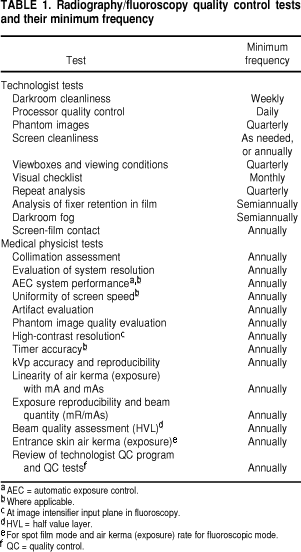Radiology Qa Programs
VIDEO: Benjamin Strong, MD, of vRad, details the essential components of a quality assurance program and how to ensure radiologist accountability and participation. Quality Assurance: The Missing Link. 1 From the Department of Radiology. The development of an automated QA program could result in. Guide for Radiation Safety/Quality Assurance. Guide for Radiation Safety/Quality Assurance Programs. Photographic Quality Assurance in Diagnostic Radiology. Age; however, all film packages should be routinely tested before use. Finally, the integrity of the dark-room (or daylight loader of an automatic processor) is.

VRad’s Quality Assurance Program vRad maintains the highest professional standards for its radiologists by employing a stringent Diagnostic Quality Assurance (QA) Program. The program is under the direction of a vRad medical director and the director of QA who also provide clinical leadership and manage. The QA Committee is comprised of practicing vRad radiologists who encompass a wide range of subspecialties and are selected because of their demonstrated high quality of interpretations. Client-submitted discrepancies — if a vRad client disagrees with a report issued by a vRad interpreting radiologist, the following protocol is used to address the case: • Submission by client — clients submit discrepancies through our or our confidential fax number. The client indicates the discrepancy details and submits the code they feel is appropriate for each QA Request.

Download Free Evanescence Special 2004 Rar Software Downloads more. The QA Request is sent to the QA Committee and the interpreting radiologist. • Review by QA Committee — the QA Request is logged into a QA database, and the case is reviewed by at least one member of the QA Committee. If the QA Committee member believes that the vRad report was correct, the case will be coded as “No QA.” If the QA Committee agrees there is a discrepancy, the case will be coded as one of the following: • Slight discrepancy with no effect on patient care • Minor discrepancy with no effect on patient care • Minor discrepancy with effect or possible effect on patient care • Major discrepancy • Review by vRad interpreting radiologist — each QA Request is also reviewed by the interpreting radiologist, who must agree or disagree and explain the reason for their initial interpretation. If the interpreting radiologist disagrees with the QA Committee’s decision, a QA Committee member contacts the interpreting radiologist to review the difference in opinion regarding the interpretation or coding.
• Client notification — the QA Committee administrator sends the client a notification via e-mail or fax confirming vRad received the QA submission, and whether the case is pending or needs more information from the client. The QA Committee administrator sends the client a fax or e-mail response when the QA Committee has reached its final decision. Alternately, the client facility may request a verbal communication from the QA Committee, in which case a committee member will contact the physician who filed the report, or his or her designee. Internal review of final interpretations — at least 1% of final interpretations are subject to our internal review process. Interpretations are randomly selected on a daily basis and submitted for review by vRad radiologists.
The QA Committee reviews all discrepancies found and categorizes the findings in the same fashion as above. The QA Committee promptly brings discrepancies on final reports to the attention of the interpreting radiologist, and the client is notified in writing of anything coded as a minor or major discrepancy. For minor and major discrepancies, an addendum may or may not be created, at the discretion of the Medical Director or QA Director. Any discrepancy that may affect patient care will be called to the local radiologist or referring physician by the, QA Committee member, or the original reading radiologist, unless an appropriate, documented follow up has already taken place related to the missed finding. Statistical analysis — The QA data collected as part of both processes, the Client-Submitted Discrepancies and the Internal Review of Final Interpretations, is stored in a database. Patient data is aggregated as appropriate according to vRad’s implementation of the Privacy and Security Rules, pursuant to the Health Insurance Portability and Accountability Act (HIPAA). The de-identified data is available on the QA Portal for use by client QA committees, including statistical review and reporting purposes.